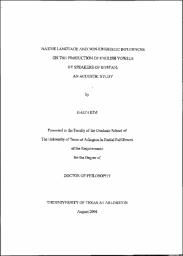| dc.description.abstract | This study investigates the production of Korean and English front vowels by ninety-one Koreans, based on their arrival age to the U.S., length of residence in the U.S. and degree of motivation. Subjects' Korean and English productions were analyzed by measuring F1, F2 and duration. Additionally, this study observed other phonological and phonetic features, such as the number of front vowel categories, the distance between the highest and lowest front vowels (Korean /i/∼/ɛ/ and English /i/∼/æ/), the distance between the lowest two vowels (Korean /e/∼/ɛ/ and English /ɛ/∼/æ/) and the lengthening effects based on the voicing of the following consonants. For Korean production, acoustic analyses show that in terms of the qualities of /i/, vowel duration and the distance between /i/ and /ɛ/, the production of the subjects who arrived in the U.S. before age 11 or those who have lived in the U.S. for more than 8 years is different from other subjects. Hence, one can infer that if people arrive in an L2 environment at an earlier age or live there for a considerable number of years, some L1 features can be changed. In addition, for the distance between Korean /e/ and /ɛ/, older generations tend to manifest a significantly longer distance, suggesting a language shift in Korean. For English production, all subjects, except for those who arrived in the U.S. before age 11, fail to produce the necessary phonetic distinctions between /i/∼/ɪ/ and /ɛ/∼/æ/, resulting in a reduction of English vowel categories. On the other hand, the qualities of /i/ and /ɛ/, vowel duration and the distance between /i/∼/æ/ improve, but they never reach native-like production, with the exception of people who arrive in the U.S. before age 11. However, the voicing-dependent vowel duration improves and reaches native-like production for some subjects. Furthermore, the Korean (L1) and English (L2) productions are compared, and the nature of phonological and phonetic interference of Korean in English pronunciation are explained. Lastly, this study concludes with pedagogical suggestions that may be useful for English learners and instructors. | en_US |


